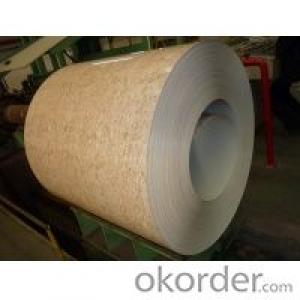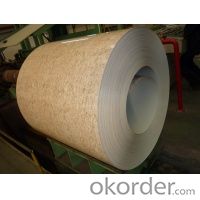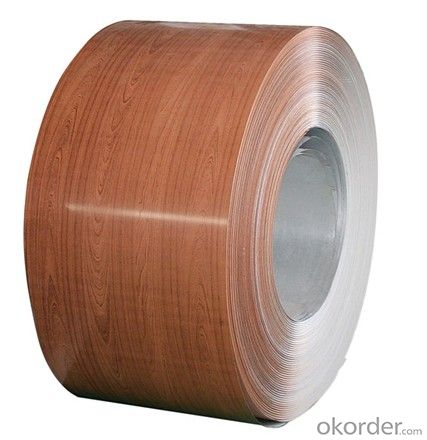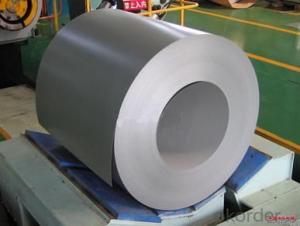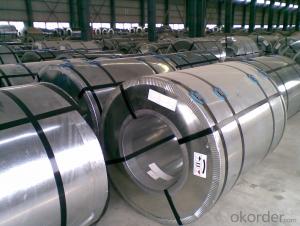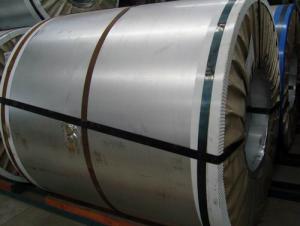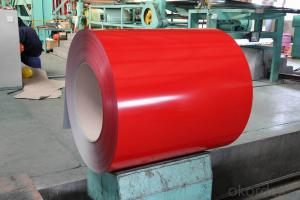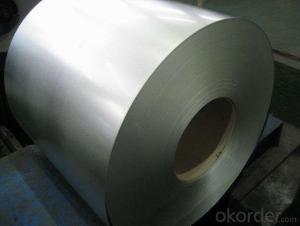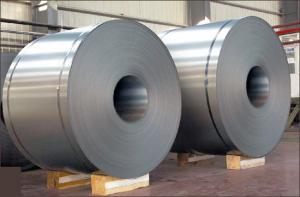Printing gavalume steel coil
- Loading Port:
- China Main Port
- Payment Terms:
- TT OR LC
- Min Order Qty:
- -
- Supply Capability:
- -
OKorder Service Pledge
Quality Product, Order Online Tracking, Timely Delivery
OKorder Financial Service
Credit Rating, Credit Services, Credit Purchasing
You Might Also Like
Packaging & Delivery
| Packaging Detail: | wrapped with waterproof paper inside, steel sheet outside,tied by steel strip, supported by pallet, then loaded in container. |
| Delivery Detail: | within 20 days after receiving the advanced T/T or L/C. |
Specifications
Specifications
1 emboss: Wood grain, marble, brick grain, camouflage
2 base sheet: gi sheet, spcc sheet
3 usage: decorativ
- Q: What are the common quality control measures for steel coils?
- Some common quality control measures for steel coils include inspection for surface defects such as scratches, dents, or unevenness, checking for dimensional accuracy and thickness consistency, testing for mechanical properties such as tensile strength and hardness, conducting chemical composition analysis, and ensuring proper packaging and labeling of the coils.
- Q: a concrete or steel building?also, what is the density of concrete and steel? is concrete heavier in steel for the same volume?
- minorchord2000 an engineer using a non-metric measuring system - it's priceless
- Q: How are steel coils used in the manufacturing of building materials?
- Due to their strength, durability, and versatility, steel coils find wide application in the production of building materials. Typically, these coils are made from high-quality steel and shaped into a continuous, flat strip. One of the primary uses of steel coils in building materials involves manufacturing steel roofing and siding. To achieve the desired dimensions and profiles, the coils undergo a series of processes that involve cutting, shaping, and rolling the steel. Consequently, the resulting roofing and siding materials are highly durable and resistant to weather, enabling the construction of long-lasting building envelopes. Additionally, steel coils are essential in the production of steel studs, which are crucial components for constructing frameworks. By cutting and forming the coils into precise shapes, they are assembled to create sturdy and rigid frameworks for walls, ceilings, and other structural elements. Notably, steel studs offer various advantages such as a high strength-to-weight ratio, fire resistance, and dimensional stability, making them a popular choice within the construction industry. Apart from roofing, siding, and framing, steel coils are utilized in the manufacturing of various other building materials. These materials encompass steel pipes, beams, columns, and reinforcement bars, which are indispensable for constructing foundations, infrastructure, and structural elements. Furthermore, steel coils serve as raw materials for fabricating metal panels, doors, windows, and other architectural components. In summary, steel coils play an indispensable role in manufacturing building materials due to their provision of necessary strength and durability for robust and long-lasting structures. Their versatility enables the production of a wide range of building components, cementing steel coils as an invaluable resource within the construction industry.
- Q: How can defects in steel coils be detected?
- Defects in steel coils can be detected through various methods such as visual inspection, non-destructive testing techniques like ultrasonic testing, magnetic particle inspection, eddy current testing, and radiographic testing. These methods help identify surface defects, internal discontinuities, cracks, or other irregularities in the steel coils.
- Q: What is the average shelf life of a steel coil?
- The average shelf life of a steel coil can vary depending on various factors such as the type of steel, storage conditions, and handling practices. However, under ideal conditions, steel coils can typically be stored for several years without significant deterioration or loss in quality.
- Q: How do steel coils resist corrosion?
- Steel coils resist corrosion due to the protective layer formed on their surface. This layer, known as a patina, acts as a barrier between the steel and the surrounding environment, preventing moisture and oxygen from reaching the metal and causing oxidation. Additionally, steel coils can be coated with corrosion-resistant materials such as zinc or paint to further enhance their resistance to corrosion.
- Q: How do steel coils contribute to sustainability in construction?
- Several factors contribute to the sustainability of construction when it comes to steel coils. To begin with, steel is an incredibly durable material with a long lifespan. Its use in the construction of structural components like beams, columns, and frames ensures the stability and strength of buildings. This durability translates to reduced maintenance requirements and a longer service life for structures. As a result, the need for frequent repairs or replacements is diminished, leading to a decrease in the overall environmental impact associated with material waste and energy consumption. Moreover, steel is highly recyclable. Steel coils can be easily recycled and reused in new construction projects. The recycling process for steel has a significantly lower environmental impact compared to the production of new steel. By incorporating recycled steel coils into construction projects, the demand for new steel production is reduced, resulting in lower greenhouse gas emissions and a smaller carbon footprint. This approach helps conserve natural resources, reduces the extraction of raw materials, and minimizes energy consumption in steel production. Additionally, steel is an ideal material for off-site prefabrication. This means that steel coils can be manufactured in controlled environments in factories, minimizing construction waste and improving construction efficiency. Prefabricating steel coils reduces on-site material waste and decreases the need for transportation of construction materials. Consequently, this reduces air pollution and energy consumption during construction. Furthermore, steel's high strength-to-weight ratio allows for lighter and more efficient structures. By using steel coils, construction projects can optimize material usage, resulting in reduced material consumption and lessening the overall environmental impact. The lightweight nature of steel coils also facilitates easier transportation, reducing fuel consumption and associated emissions during delivery. In summary, steel coils contribute to the sustainability of construction through their durability, recyclability, prefabrication capabilities, and high strength-to-weight ratio. By utilizing steel coils, construction projects can minimize waste, conserve resources, reduce energy consumption, and decrease the environmental impact, ultimately promoting a more sustainable built environment.
- Q: What is the role of steel coils in the manufacturing of bridges?
- Steel coils play a crucial role in the manufacturing of bridges as they are used as the primary material for constructing the structural components of the bridge, such as beams, columns, and girders. These coils are manufactured by rolling steel into flat strips, which are then wound into large coils. The high strength and durability of steel make it an ideal choice for bridge construction, as it can withstand heavy loads, extreme weather conditions, and provide long-lasting support. The coils are processed further to fabricate the required bridge components, ensuring the structural integrity and stability of the bridge.
- Q: What are the different methods of coating steel coils?
- There are several different methods of coating steel coils, including hot-dip galvanizing, electro-galvanizing, and organic coating.
- Q: What are the disadvantages of using steel coils?
- One of the main disadvantages of using steel coils is their weight, which can make transportation and handling more challenging and costly. Additionally, steel coils are prone to corrosion if not properly coated or protected, which can negatively impact their lifespan and performance. Another downside is their limited flexibility and difficulty in shaping, which may restrict their application in certain industries. Lastly, steel coils can be expensive to produce and acquire, making them less cost-effective compared to alternative materials in some cases.
Send your message to us
Printing gavalume steel coil
- Loading Port:
- China Main Port
- Payment Terms:
- TT OR LC
- Min Order Qty:
- -
- Supply Capability:
- -
OKorder Service Pledge
Quality Product, Order Online Tracking, Timely Delivery
OKorder Financial Service
Credit Rating, Credit Services, Credit Purchasing
Similar products
Hot products
Hot Searches
Related keywords
